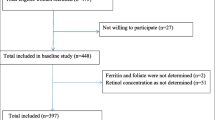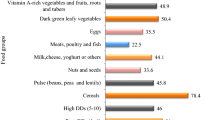Abstract
Pregnant women in developing countries are vulnerable to multiple micronutrient deficiencies. Studies assessing serum levels of the micronutrients and magnitude of their deficiencies are very scarce in African subjects. This study was aimed at determining serum levels of micronutrients in 375 pregnant (42 HIV seropositive) and 76 non-pregnant women (20 HIV seropositive) who visited the University of Gondar Hospital, Gondar, Ethiopia. Serum concentrations of zinc,\ copper, selenium, calcium, and magnesium were determined using an inductively coupled plasma mass spectrometer. Irrespective of HIV serostatus, pregnant women had significantly higher serum concentrations of copper and copper/zinc ratio and significantly lower magnesium compared to those in non-pregnant women (P < 0.05). Except for selenium, which was significantly lower in HIV-seropositive pregnant women (P < 0.05), the mean serum concentrations of zinc, copper, calcium, and magnesium were not significantly different between pregnant women by HIV serostatus. The prevalence of deficiency in zinc, magnesium, selenium, and calcium in the pregnant women, irrespective of their HIV serostatus, was 66.7%, 25.6%, 21.9%, and 9.3%, respectively. The magnitude of deficiency in zinc, magnesium, and selenium was significantly higher in HIV seropositive pregnant women (76.2%, 52.4%, and 45.2%) than that in HIV-seronegative pregnant women (65.5%, 22.2%, and 18.9%) and in HIV-seronegative non-pregnant women (42.9%, 8.1%, and 30.4%; P < 0.05). Deficiency in one, two, three, or four mineral elements was observed in 44.8%, 14.4%, 9.9%, and 5.1% of the pregnant women, respectively. Only 25.9% of the pregnant women and 44.7% of the non-pregnant women were not deficient in any of the micronutrients. The high prevalence of micronutrient deficiencies in pregnant and non-pregnant women in Gondar, Ethiopia warrants the need for strategies on prevention and control of the deficiencies.
Similar content being viewed by others
References
WHO (1996) Trace elements in human nutrition and health. WHO, Geneva, Switzerland
Failla ML (2003) Trace elements and host defense: recent advances and continuing challenges. J Nutr 133:1443S–1447S
Black RE (2001) Micronutrients in pregnancy. Br J Nutr 85:S193–S197
Abdulla M, Khan AH, Reis MF (1996) Trace element nutrition in developing countries. Asia Pacific J Clin Nutr 5:186–190
Ramakrishnan U (2002) Prevalence of micronutrient malnutrition worldwide. Nutr Rev 60:S46–S52
Seshadri S (2001) Prevalence of micronutrient deficiency particularly of iron, zinc and folic acid in pregnant women in South East Asia. Br J Nutr 85:S87–S92
Christian P (2003) Micronutrients and reproductive health issues: an international perspective. J Nutr 133:1969S–1973S
King JC (2000) Physiology of pregnancy and nutrient metabolism. Amer J Clin Nutr 71:1218–1225
Kontic-Vucinic O, Sulovic N, Radunovic N (2006) Micronutrients in women's reproductive health: II. Minerals and trace elements. Int J Fertil Womens Med 51:116–124
Ramakrishnan U, Manjrekar R, Rivera J, Gonzales-Cossio T, Martorell R (1999) Micronutrients and pregnancy outcome: a review of the literature. Nutr Res 19:103–159
Seydoux J, Girardin E, Paunier L, Beguin F (1992) Serum and intracellular magnesium during normal pregnancy and in patients with pre-eclampsia. Br J Obstet Gynecol 99:207–211
Yasodhara P, Ramaraju LA, Raman L (1994) Trace minerals in pregnancy 1. Copper and zinc. Nutr Res 11:15–21
Martin-Lagos F, Navarro-Alarcon M, Terres-Martos C, Lopez-Garcia de la Serrana H, Perez-Valero V, Lopez-Martinez MC (1998) Zinc and copper concentrations in serum from Spanish women during pregnancy. Biol Trace Elem Res 61:61–70
Tamura T, Goldenberg RL, Johnston KE, DuBard M (2000) Maternal plasma zinc concentrations and pregnancy outcome. Am J Clin Nutr 71:109–113
Ma AG, Chen XC, Xu RX, Zheng MC, Wang Y, Li JS (2004) Comparison of serum levels of iron, zinc and copper in anaemic and non-anemic pregnant women in China. Asia Pac J Clin Nutr 13:348–352
Pathak P, Kapil U, Kapoor SK et al (2004) Prevalence of multiple micronutrient deficiencies amongst pregnant women in a rural area of Haryana. Indian J Pediatr 71:1007–1014
Ethiopian Health and Nutrition Research Institute (2002) Manual for HIV-1 diagnosis. Ethiopian Health and Nutrition Research Institute, Addis Ababa, Ethiopia
Kassu A, Yabutani T, Mahmud ZH et al (2006) Alterations in serum levels of trace elements in tuberculosis HIV infection. Eur J Clin Nutr 60:580–586
Sauberlich HE (1999) Laboratory tests for the assessment of nutritional status, 2nd edn. CRC, Boca Raton
Ethiopian Ministry of Health (2006) AIDS in Ethiopia, 6th edn. Ethiopian Ministry of Health, Addis Ababa, Ethiopia
Kapil U, Pathak P, Singh P, Singh C (2002) Zinc and magnesium nutriture amongst pregnant mothers of urban slum communities in Delhi: a pilot study. Indian Pediatr 39:365–368
Gibson RS (1994) Zinc nutrition in developing countries. Nutr Res Rev 7:151–173
Krebs NF (2000) Overview of zinc absorption and excretion in the human gastrointestinal tract. J Nutr 130(5S Suppl):1374S–1377S
Kalra R, Kalra VB, Sareen PM, Khandelwal R (1989) Serum copper and ceruloplasmin in pregnancy with anaemia. Indian J Pathol Microbiol 32:28–32
Olivares M, Uauy R (1996) Copper as an essential nutrient. Am J Clin Nutr 63:791–796
Creizel AE (1995) Nutritional supplementation and prevention of congenial abnormalities. Curr Opin Obstet Gynecol 2:88–94
Gupta AP, Bhandari B, Gupta A (1984) Serum copper, zinc, magnesium and calcium in neonates. Indian Pediatr 21:469–473
Hall DG (1957) Serum magnesium during pregnancy. Obstet Gynecol 9:158–162
Grollman A, Grollman EF (1965) Pharmacology and therapeutics, 6th edn. Lea, Philadelphia
Chien PFW, Khan KS, Arnott N (1996) Magnesium sulphate in the treatment of eclampsia and pre-eclampsia: an overview of the evidence from randomized trials. Brit J Obstetr Gynecol 103:1085–1091
Almonte RA, Heath DL, Whitehall J, Russell MJ, Pathole S, Vink R (1999) Gestational magnesium deficiency is deleterious to fetal outcome. Biol Neonate 76:26–32
McKenzie RC, Rafferty TS, Beckett GJ (1998) Selenium: an essential element for immune function. Immunol Today 19:342–345
Zachara BA, Wardak C, Didkowski W, Maciag A, Marchaluk E (1993) Changes in blood selenium and glutathione concentrations and glutathione peroxidase activity in human pregnancy. Gynekol Obstet Invest 35:12–17
Hamlin RJH (1962) Prevention of preeclampsia. Lancet 1:864–865
Lagerkvist BJ, Ekesrydh S, Englyst V, Nordberg GF, Söderberg HA, Wiklund DE (1996) Increased blood lead and decreased calcium levels during pregnancy: a prospective study of Swedish women living near a smelter. Am J Public Health 86:1247–1252
Lonnerdal B (2000) Dietary factors influencing zinc absorption. J Nutr 130:1378S–1383S
Acknowledgments
Financial support was provided by University of Gondar, Ethiopia and partly by Sasakawa Scientific Research Grant from the Japan Science Society (no. 17-241).
Author information
Authors and Affiliations
Corresponding author
Rights and permissions
About this article
Cite this article
Kassu, A., Yabutani, T., Mulu, A. et al. Serum Zinc, Copper, Selenium, Calcium, and Magnesium Levels in Pregnant and Non-Pregnant Women in Gondar, Northwest Ethiopia. Biol Trace Elem Res 122, 97–106 (2008). https://doi.org/10.1007/s12011-007-8067-6
Received:
Revised:
Accepted:
Published:
Issue Date:
DOI: https://doi.org/10.1007/s12011-007-8067-6




